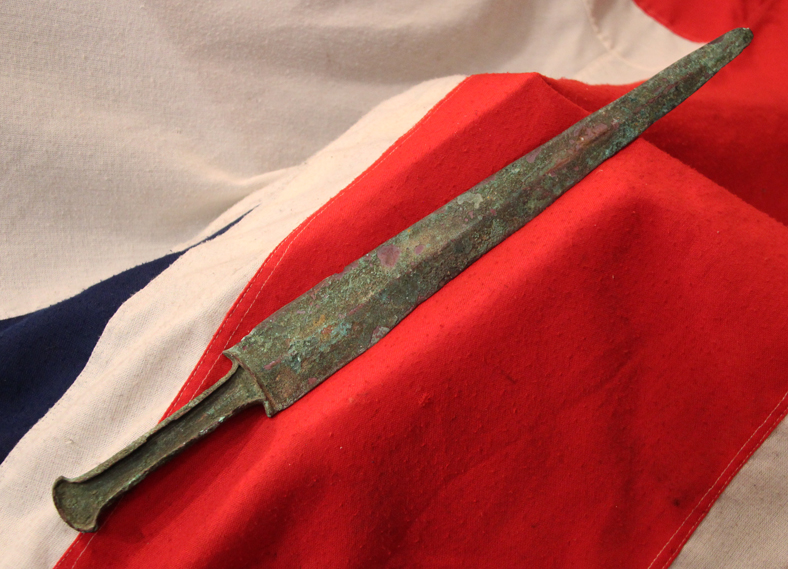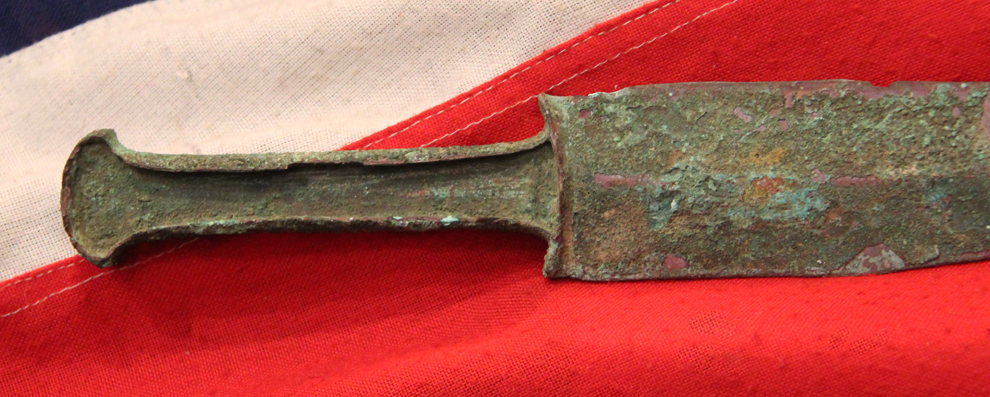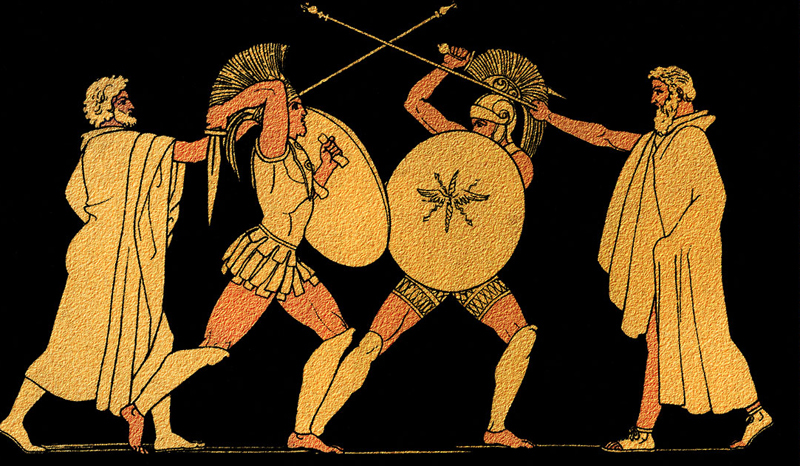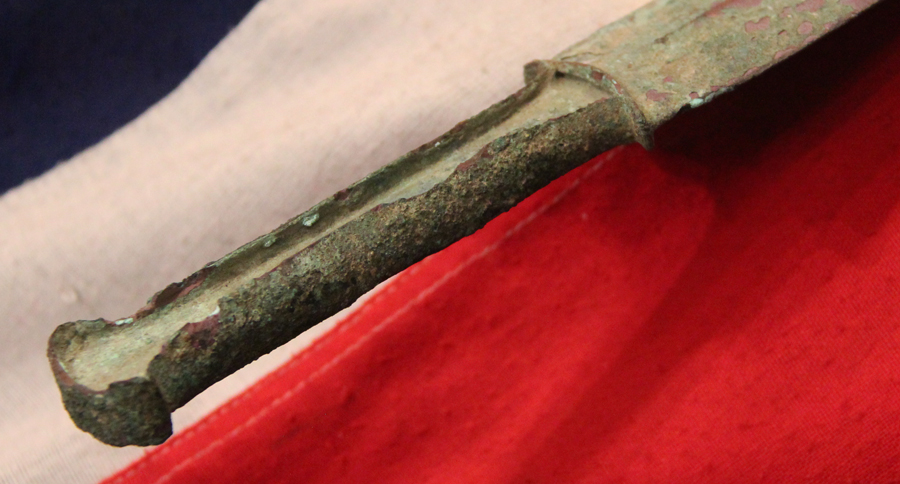A Wonderful Circa 3000 Year Old Original Sword From the Time of the Ancient Greek 'Heroic Age' Such as The Era of The Seige of Troy and The Trojan War
One of two absolute beauties from the same historical era we were delighted to acquire. In beautiful condition with very fine deep patination. The first sword of the two has now just sold.
It has a graduating blade with central rib, integral hilt, with open panels for organic inserts of wood, bone, or ivory, fabulous areas of crystalized malachite naturally aged blue/green patination.
The great bronze age artisans of the time, found a most eager market to supply the warriors of late pre-literary history. Interestingly their swords and daggers were traded to all the warring cultures, from the Ancient Macedonians, Minoans, Thracians, Spartans, Scythians, Trojans and of course the Medes. So it was potentially possible at the time to find two civilizations at war using combat weapons made by the very same artisans, such as from Luristan or Crete. Crete being one of the main sources of copper in the bronze age, within that region. A type of globalization was in place, as all of the major powers were interconnected. Trade networks exchanged glass, ivory, copper, tin, bronze, perfume, and pottery. Bronze could be seen as the equivalent of our modern economy's crude oil. It was used for axes, swords, knives, armour, plows, and even wheel mechanisms, and tin, an essential ingredient of bronze, was traded as far as 1000 miles from its mined source in Afghanistan. Out of interest, it was why Ancient Rome spent so much time and effort in order to conquer ancient Britain, it was for our Cornish tin, and numerous lead mines, and not for our glorious climate.
The Greek Heroic Age, in mythology, is the period between the coming of the Greeks to Thessaly and the Greek warriors' return from Troy after their return with Helen of Troy. The poet Hesiod (fl. c. 700 BCE) identified this mythological era as one of his five Ages of Man. The period spans roughly six generations; the heroes denoted by the term are superhuman, though not divine, and are celebrated in the literature of Homer and of others, such as Sophocles, Aeschylus and Euripides.
The Greek heroes can be grouped into an approximate mythic chronology, based on the stories of events such as the Argonautic expedition and the Trojan War. Over the course of time, many heroes, such as Heracles, Achilles, Hector and Perseus, came to figure prominently in Greek mythology.
Early heroes
Many of the early Greek heroes were descended from the gods and were part of the founding narratives of various city-states. They also became the ancestors of later heroes. The Phoenician prince Cadmus, a grandson of Poseidon, was the first Greek hero and the founder of Thebes.
Perseus, famous for his exploits well before the days of his great-grandson, Heracles, was the son of Zeus. Perseus beheaded the Medusa, saved Andromeda from the sea monster Cetus, and was the legendary founder of Mycenae.
Aeacus was also a son of Zeus. Bellerophon was descended from the nymph Orseis. Oenomaus, king of Pisa, in the Peloponnese, was the son of Ares.
Among these early heroes the three - Cadmus, Perseus and Bellerophon - were considered the greatest Greek heroes and slayers of monsters before the days of Heracles.
Of course, despite the Age of Heroes and the time of the Gods of Olympus, being based almost entirely on mythology, apart from the actual city of Troy, which is now proved to be not a myth, the real warriors that lived during that age and time, in ancient pre-history, actually existed, and this is their very form of sword, and one that they would have used.
It is in beautiful condition, with very fine deep natural patination created over 3000 years. A sword type that gained popularity by the Eastern Mediterranean Scythians, Mycenaean Greek, The Spartans and during the the late 2nd Millenium to the Ist millennium B.C. around 2700 to 3200 years ago, and also, not least by the Medes of Persia.
Bronze swords and daggers weapons were highly sought after by warriors of many cultures because of their quality, balance and durability, and the artisans that made them found a ready market throughout all of the late pre-literary history cultures.
Typically their swords would have a graduating blade with central rib, integral hilt, with open panels for organic inserts of wood, bone, or ivory, just as this sword has, but it now has gained fabulous areas of crystallized malachite, naturally aged as a blue/green patination.
This is a type of short sword used mainly in the late second to first millennium BC in the eastern Mediterranean region, it was was worn at the hip in a likely, elaborate scabbard. The scabbard's chape, was generally a rounded triangle, and could be made of bronze, chased gold or carved ivory, and potentially lots of other materials. Just above the chape, a cord was tied around the scabbard, passed around the thigh and then through a slip-knot next to the chape.
The throat of thge scabbard had a large tab, which at its own upper corner was tied through a hole in the weapon belt.
Last picture in the gallery is the Recovery of Helen by Menelaus. Painted Attic black-figure amphora, c. 550 BC
19 1/2 inches long overall, blade 15 inches long
Code: 22086
1975.00 GBP










